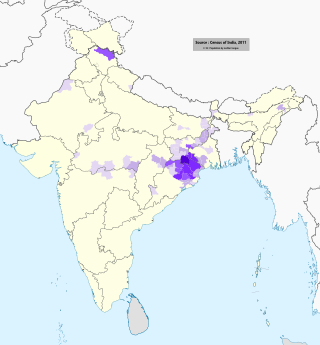
Back Ho Afrikaans हो भाषा ANP اللغة الهويوية Arabic Tataramon na Ho BCL Хо (език) Bulgarian হো ভাষা Bengali/Bangla Hoeg Breton Ho (llengua) Catalan Ho (sprog) Danish Hoki DIQ
This article's tone or style may not reflect the encyclopedic tone used on Wikipedia. The reason given is: bad headings and promotional (June 2024) |
| Ho | |
|---|---|
| 𑢹𑣉𑣉 𑣎𑣋𑣜, हो जगर, ହୋ ଜାଗାର, হো জাগার | |
 'Hō jagar' written in Warang Chiti | |
| Pronunciation | /hoː d͡ʑagar/ |
| Native to | India |
| Ethnicity | Ho people |
Native speakers | 1,421,418 (2011 census)[1] |
Austroasiatic
| |
| Warang Chiti, Devanagari, Latin script, Odia script[2] | |
| Official status | |
Official language in |
|
| Language codes | |
| ISO 639-3 | hoc |
| Glottolog | hooo1248 |
 Ho language speaking region | |
 Ho is classified as Vulnerable by the UNESCO Atlas of the World's Languages in Danger[3] | |
Ho (IPA: [hoː d͡ʑagar], Warang Citi: 𑢹𑣉𑣉 𑣎𑣋𑣜) is a Munda language of the Austroasiatic language family spoken primarily in India by about 2.2 million people (0.202% of India's population) per the 2001 census. It is spoken by the Ho, Munda, Kolha and Kol tribal communities of Jharkhand, Odisha, West Bengal and Assam[4] and is written using Warang Citi script. Devanagari, Latin and Odia script are also used,[5] although native speakers are said to prefer Warang Chiti, invented by Lako Bodra.[6]
The name Ho is derived from the native word "𑣙𑣉𑣉" meaning human being.[7]
Ho is closely related to Mundari and Santali. Ho and Mundari are often described as sister languages.[7][8] Ho is closer to the Mayurbhanj dialect of Mundari than the Mundari variety spoken in Jharkhand. While being ethnically and linguistically close, Ho and Mundari speakers form distinct regional identities.
- ^ "C-16 POPULATION BY MOTHER TONGUE". www.censusindia.gov.in. Office of the Registrar General & Census Commissioner, India. Retrieved 11 July 2024.
- ^ "Scripts of Ho". Scriptsource.org. Retrieved 26 August 2021.
- ^ Moseley, Christopher; Nicolas, Alexander, eds. (2010). Atlas of the World's Languages in Danger (PDF) (3rd ed.). Paris: UNESCO. pp. 46–47. ISBN 978-92-3-104096-2. Archived from the original on 23 July 2022.
- ^ "Tribals seek official tag for Ho language - OrissaPOST". 27 October 2018. Retrieved 16 December 2019.
- ^ "The Warang Chiti Alphabet". Swarthmore.edu. Retrieved 19 March 2015.
- ^ K David Harrison; Gregory Anderson. "Review of Proposal for Encoding Warang Chiti (Hoorthography) in Unicode" (PDF). Retrieved 19 March 2015.
- ^ a b "Ho Web Sketch: Ho writing" (PDF). Livingtongues.org. Archived from the original (PDF) on 17 March 2016. Retrieved 19 March 2015.
- ^ Anderson, Gregory S., ed. (2008). The Munda languages (1. publ. ed.). London: Routledge. ISBN 978-0-415-32890-6.